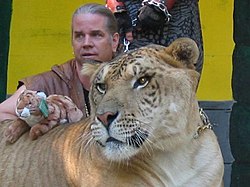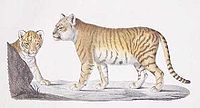The history of lion-tiger hybrids dates to at least the early 19th century in India. In 1798, Étienne Geoffroy Saint-Hilaire (1772–1844) made a colour plate of the offspring of a lion and a tiger. The portmanteau "liger" was coined by the 1930s.[4]
In 1825, G. B. Whittaker made an engraving of liger cubs born in 1824.[3] The parents and their three liger offspring are also depicted with their trainer in a 19th-century painting in the naïve style.
Two liger cubs born in 1837 were exhibited to King William IV and to his successor Queen Victoria. On 14 December 1900 and on 31 May 1901, Carl Hagenbeck wrote to zoologist James Cossar Ewart with details and photographs of ligers born at the Hagenbeck's Tierpark in Hamburg in 1897.
In Animal Life and the World of Nature (1902–1903), A.H. Bryden described Hagenbeck's "lion-tiger" hybrids:
In 1935, four ligers from two litters were reared in the Zoological Gardens of Bloemfontein, South Africa. Three of them, a male and two females, were still living in 1953. The male weighed 340 kg (750 lb) and stood a foot and a half (45 cm) taller than a full grown male lion at the shoulder.
Although ligers are more commonly found than tigons today, in At Home In The Zoo (1961), Gerald Iles wrote "For the record I must say that I have never seen a liger, a hybrid obtained by crossing a lion with a tigress. They seem to be even rarer than tigons."[6]
Size and growth
The liger is often believed to represent the largest known cat in the world.[1] Males reach a total length of 3 to 3.6 m,[7][8] meaning they are larger than large Siberian tigermales, who are themselves usually larger than the larger lion species.[9] Imprinted genes may be a factor contributing to the large size of ligers.[10] These are genes that may or may not be expressed on the parent they are inherited from, and that occasionally play a role in issues of hybrid growth. For example, in some dog breed crosses, genes that are expressed only when maternally-inherited cause the young to grow larger than is typical for either parent breed. This growth is not seen in the paternal breeds, as such genes are normally "counteracted" by genes inherited from the female of the appropriate breed.[11]
Other big cat hybrids can reach similar sizes; the litigon, a rare hybrid of a male lion and a female tigon, is roughly the same size as the liger, with a male named Cubanacan (at the Alipore Zoo in India) reaching 363 kg (800 lb).[12] The extreme rarity of these second-generation hybrids may make it difficult to ascertain whether they are larger or smaller, on average than the liger.
It is wrongly believed that ligers continue to grow throughout their lives due to hormonal issues.[citation needed] It may be that they simply grow far more during their growing years and take longer to reach their full adult size. Further growth in shoulder height and body length is not seen in ligers over 6 years old, as in both lions and tigers. Male ligers also have the same levels of testosterone on average as an adult male lion, yet are azoospermic in accordance with Haldane's rule. In addition, female ligers may also attain great size, weighing approximately 320 kg (705 lb) and reaching 3.05 m (10 ft) long on average, and are often fertile. In contrast, pumapards (hybrids between pumasand leopards) tend to exhibit dwarfism.
Ligers are about the same size as the prehistoric Smilodon populator and American lion.
Hercules the liger
Hercules, the largest non-obese liger, is recognised by the Guinness Book of World Records as the largest living cat on Earth, weighing 418.2 kg (922 lb).[13][14] Hercules was featured on the Today Show, Good Morning America, Anderson Cooper 360, Inside Edition, and in a Maxim article in 2005, when he was only three years old and already weighed 408.25 kg (900 lb). Hercules is healthy and is expected to live a long life. The cat's breeding is said to have been a complete accident.
Longevity
Shasta, a ligress (female liger) was born at the Hogle Zoo in Salt Lake City on 14 May 1948 and died in 1972 at age 24.[15] Valley of the Kings animal sanctuary in Wisconsin had a male liger named Nook who weighed over 550 kg (1,213 lb), and died in 2007, at 21 years old.[2] Hobbs, a male liger at the Sierra Safari Zoo in Reno, Nevada, lived to almost 15 years of age before succumbing to liver failure and weighed in at 450 kg (992 lb).[16] This liger was born in 1943 and died in 1960. South Africa still has two ligers at its one zoo at Bloemfontein.[17]
Fertility
The fertility of hybrid big cat females is well documented across a number of different hybrids. This is in accordance with Haldane's rule: in hybrids of animals whose sex is determined by sex chromosomes, if one sex is absent, rare or sterile, it is the heterogametic sex (the one with two different sex chromosomes e.g. X and Y).
According to Wild Cats of the World (1975) by C. A. W. Guggisberg, ligers and tigons were long thought to be sterile: in 1943, a fifteen-year-old hybrid between a lion and an 'Island' tiger was successfully mated with a lion at the Munich Hellabrunn Zoo. The female cub, though of delicate health, was raised to adulthood.[18]
In September 2012, the Russian Novosibirsk Zoo announced the birth of a "liliger", which is the offspring of a liger mother and a lion father. The cub was named Kiara.[19]
Appearance
Ligers have a tiger-like striped pattern that is very faint upon a lionesque tawny background. In addition, they may inherit rosettes from the lion parent (lion cubs are rosetted and some adults retain faint markings). These markings may be black, dark brown or sandy. The background colour may be correspondingly tawny, sandy or golden. In common with tigers, their underparts are pale. The actual pattern and colour depend on which subspecies the parents were and on how the genes interact in the offspring.
White tigers have been crossed with lions to produce "white" (actually pale golden) ligers. In theory, white tigers could be crossed with white lions to produce white, very pale or even stripeless ligers. There are no black ligers. Very few melanistic tigers have ever been recorded, most being due to excessive markings (pseudo-melanism or abundism) rather than true melanism; no reports of black lions have ever been substantiated. As blue or Maltese tigers probably no longer exist, grey or blue ligers are exceedingly improbable. It is not impossible for a liger to be white, but it is very rare.






















